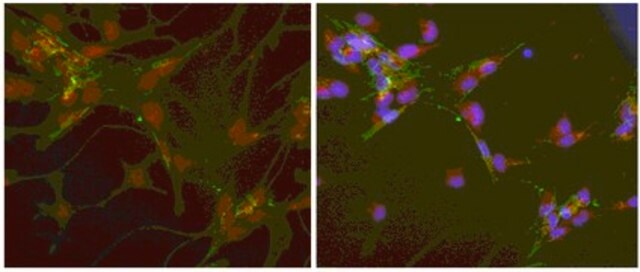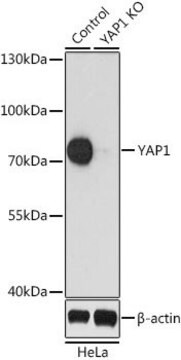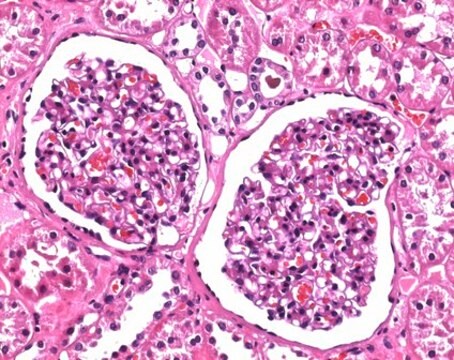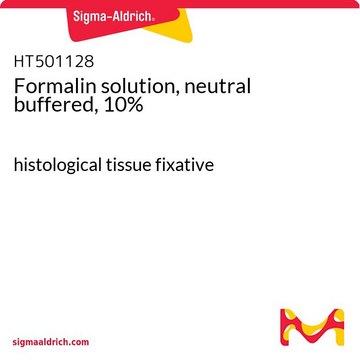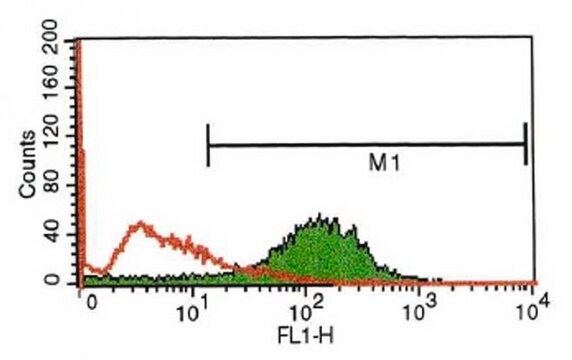推薦產品
生物源
mouse
品質等級
共軛
unconjugated
抗體表格
purified immunoglobulin
抗體產品種類
primary antibodies
無性繁殖
P1H12, monoclonal
形狀
buffered aqueous solution
分子量
antigen 130 kDa
物種活性
human
技術
flow cytometry: suitable using 2% paraformaldehyde 9:1 methanol
immunocytochemistry: suitable using 4% paraformaldehyde 0.1-0.5% triton X-100, smears or live cells
immunohistochemistry: suitable using using acetone-fixed sections of human tongue
immunoprecipitation (IP): suitable
indirect ELISA: suitable
microarray: suitable
同型
IgG1
運輸包裝
dry ice
儲存溫度
−20°C
目標翻譯後修改
unmodified
一般說明
Monoclonal Anti-Endothelial cells (CD146) (mouse IgG1 isotype) is derived from the P1H12 hybridoma produced by the fusion of mouse myeloma cells and splenocytes from mice immunized with human umbilical cord cells (HUVEC). CD146 (cluster of differentiation 146) is also known as the melanoma cell adhesion molecule (MCAM), cell surface glycoprotein MUC18, A32, Mel-CAM and S-Endo-1. It is encoded by the MCAM gene. It belongs to the immunoglobulin supergene family with five immunoglobulin-like domains (V-V-C2-C2-C2), a transmembrane region and a 63 residue cytoplasmic tail. It is located on human chromosome11q23.
特異性
Recognizes cultured microvascular and large-vessel endothelial cells (MVEC and HUVEC, respectively) and endothelial cells in tissues and in circulation.
免疫原
human umbilical cord cells (HUVEC).
應用
Anti-Endothelial Cells antibody, Mouse monoclonal has been used in:
- immunocytochemistry
- immunohistochemistry
- flow cytometry
- immunoprecipitation
- enzyme-linked immunosorbent assay (ELISA)
- western blotting
生化/生理作用
CD146 (cluster of differentiation 146) expression can stimulate tumor development in human melanoma, through enhanced interaction between melanoma cells and endothelial cells. However, in breast carcinoma, CD146 may act as a tumor suppressor. CD146 is expressed by the intermediate trophoblast in the placental site and binds to its putative receptor in uterine smooth muscle cells during implantation and placentation, thus limiting trophoblastic invasion in the myometrium.
Soluble CD146 (cluster of differentiation 146) is associated with the activation of angiogenesis. Circulating endothelial cells (CECs) may help in predicting clinical outcome in cancer patients. Tumor endothelial markers are expressed in a wide range of tumor types and in normal vessels associated with wound healing and corpus luteum formation. It may have significant implications for the development of anti-angiogenic therapies as well.
外觀
Solution in 0.01 M phosphate buffered saline, pH 7.4, containing 15 mM sodium azide
免責聲明
Unless otherwise stated in our catalog or other company documentation accompanying the product(s), our products are intended for research use only and are not to be used for any other purpose, which includes but is not limited to, unauthorized commercial uses, in vitro diagnostic uses, ex vivo or in vivo therapeutic uses or any type of consumption or application to humans or animals.
未找到適合的產品?
試用我們的產品選擇工具.
儲存類別代碼
12 - Non Combustible Liquids
水污染物質分類(WGK)
nwg
閃點(°F)
Not applicable
閃點(°C)
Not applicable
The role of CD146 (Mel-CAM) in biology and pathology
Shih IM
The Journal of Pathology, 189(1), 4-11 (1999)
Expression of CD markers in JAK2V617F positive myeloproliferative neoplasms: Prognostic significance
Shahrabi S, et al.
Oncology reviews, 12(2) (2018)
Y Lin et al.
The Journal of clinical investigation, 105(1), 71-77 (2000-01-05)
Normal adults have a small number of circulating endothelial cells (CEC) in peripheral blood, and endothelial outgrowth has been observed from cultures of blood. In this study we seek insight into the origins of CEC and endothelial outgrowth from cultures
M Ilie et al.
British journal of cancer, 110(5), 1236-1243 (2014-01-30)
Previous studies indicate that endothelial injury, as demonstrated by the presence of circulating endothelial cells (CECs), may predict clinical outcome in cancer patients. In addition, soluble CD146 (sCD146) may reflect activation of angiogenesis. However, no study has investigated their combined
Targeting CD146 with a 64Cu-labeled antibody enables in vivo immunoPET imaging of high-grade gliomas
Yang Y, et al.
Proceedings of the National Academy of Sciences of the USA, 112(47), E6525-E6534 (2015)
我們的科學家團隊在所有研究領域都有豐富的經驗,包括生命科學、材料科學、化學合成、色譜、分析等.
聯絡技術服務